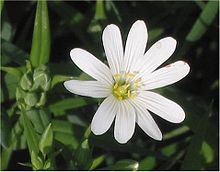Rabelera holostea, known as greater stitchwort, greater starwort,[1] and addersmeat,[2] is a perennial herbaceous flowering plant in the family Caryophyllaceae. It was formerly placed in the genus Stellaria, as Stellaria holostea, but was transferred to the genus Rabelera in 2019 based on phylogenetic analyses.[3][4][5][6] It is the only species in the genus Rabelera. Greater stitchwort is native to Western and Central Europe, including the British Isles.
| Rabelera holostea | |
|---|---|

| |
| Distinctive deeply notched petals | |
| Scientific classification | |
| Kingdom: | Plantae |
| Clade: | Tracheophytes |
| Clade: | Angiosperms |
| Clade: | Eudicots |
| Order: | Caryophyllales |
| Family: | Caryophyllaceae |
| Genus: | Rabelera M.T.Sharples & E.A.Tripp |
| Species: | R. holostea
|
| Binomial name | |
| Rabelera holostea (L.) M.T.Sharples & E.A.Tripp
| |
| Synonyms | |
|
List
| |
Greater stichwort can be found in woodlands, edges, and open fields[7] and is sometimes grown in gardens.[8]
Description
editGreater stitchwort can grow up to 60 cm (24 in) in height, with roughly 4-angled stems. The long, narrow (lanceolate) leaves are greyish green, hairless, sessile, opposite, and decussate (the successive pairs borne at right angles to each other).[9]: 460 [10]: 90 [11]
The flowers are white, 2–3 cm (0.79–1.18 in) across, with five petals split to about halfway the length of the petal. The sepals are much shorter than the petals.[11][12]
-
Flowers
-
Leaves
-
With a small yellow underwing, Panemeria tenebrata
Taxonomy
editEtymology
editThe specific epithet holostea comes from the Greek holosteon, meaning 'entire bone'; a reference to the brittleness of the weak stems of this plant.[13][citation needed]
Common names
editThe common name stitchwort is a reference to a herbal remedy in which this plant is used allegedly to cure side stitch, which afflicts many people when they try to run without stretching first.[14] Other common names for Rabelera holostea include: daddy's-shirt-buttons, poor-man's buttonhole, brassy buttons, wedding cakes, star-of-Bethlehem, and snapdragon.[8][7] Many of these names are in reference to the stems, which easily break.[8]
References
edit- ^ Brouillet L, Desmet P, Coursol F, Meades SJ, Favreau M, Anions M, Bélisle P, Gendreau C, Shorthouse D, et al. (2010). "Stellaria holostea L." Database of Vascular Plants of Canada (VASCAN). Retrieved 27 May 2020.
- ^ USDA, NRCS (n.d.). "Stellaria holostea". The PLANTS Database (plants.usda.gov). Greensboro, North Carolina: National Plant Data Team. Retrieved 1 December 2015.
- ^ Sharples, Mathew T.; Tripp, Erin A. (14 December 2019). "Phylogenetic Relationships Within and Delimitation of the Cosmopolitan Flowering Plant Genus Stellaria L. (Caryophyllaceae): Core Stars and Fallen Stars". Systematic Botany. 44 (4): 857–876. doi:10.1600/036364419X15710776741440. S2CID 208176757.
- ^ "Rabelera holostea (L.) M.T.Sharples & E.A.Tripp". ipni.org. International Plant Names Index. Retrieved 27 May 2020.
- ^ Weakley, Alan S. (2020), Flora of the Southern and Mid-Atlantic States, University of North Carolina Herbarium, North Carolina Botanical Garden, University of North Carolina at Chapel Hill
- ^ "Rabelera holostea (L.) M.T.Sharples & E.A.Tripp {ID 7523}". www.floraitaliae.actaplantarum.org. Retrieved 28 May 2020.
- ^ a b "Greater stitchwort". www.wildlifetrusts.org. Retrieved 27 May 2020.
- ^ a b c Fowler, Alys (24 May 2014). "Alys Fowler: stitchwort". the Guardian. Retrieved 28 May 2020.
- ^ Stace, C. A. (2010). New Flora of the British Isles (Third ed.). Cambridge, U.K.: Cambridge University Press. ISBN 9780521707725.
- ^ Blamey, M.; Fitter, R.; Fitter, A (2003). Wild flowers of Britain and Ireland: The Complete Guide to the British and Irish Flora. London: A & C Black. ISBN 978-1408179505.
- ^ a b Sterry, Paul (1997). Complete British Wildlife. London: HarperCollins. p. 240. ISBN 978-0-583-33638-3.
- ^ Waller, Chris (1981). Nature Guide to the Lake District. London: Usborne Publishing. p. 72. ISBN 0-86020-403-0.
- ^ Pliny the Elder. Natural History. Book 27. Chapter 65
- ^ Stellaria holostea - Greater Stitchwort Retrieved 15 May 2017.